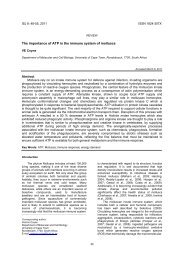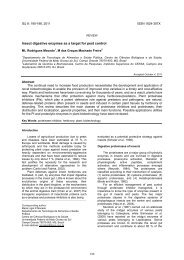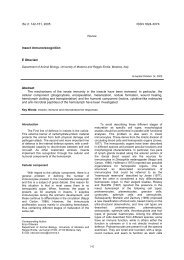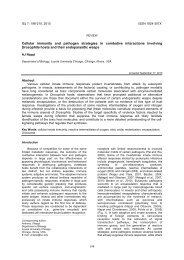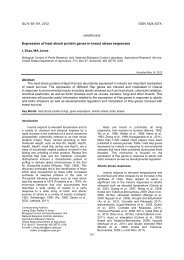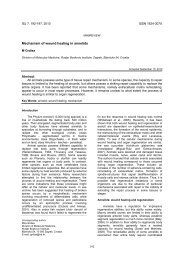Parasite-host relationship: a lesson from a professional killer
Parasite-host relationship: a lesson from a professional killer
Parasite-host relationship: a lesson from a professional killer
Create successful ePaper yourself
Turn your PDF publications into a flip-book with our unique Google optimized e-Paper software.
Characterization of a cytotoxic pilin subunit of<br />
Xenorhabdus nematophila. Biochem. Biophys. Res.<br />
Commun. 314: 943-949, 2004.<br />
Lie KJ and Heyneman D. Studies on resistance in snails.<br />
Escape of Echinostoma lindoense sporocistis <strong>from</strong><br />
encapsulation in the snail heart and subsequent loss of<br />
the <strong>host</strong>’s abilty to resist infection by the same parasite.<br />
J. Parasitol. 62:298-302, 1976.<br />
Loker ES. On being a parasite in an invertebrate <strong>host</strong>: a<br />
short survival course. J. Parasitol. 80: 728-747, 1994.<br />
Maizels RM, Blaxter M., Selkirk ME. Forms and functions of<br />
nematode surfaces. Exp. Parasitol. 77: 380-384, 1993.<br />
McGuinness DH, Dehal PK, Pleass RJ. Pattern recognition<br />
molecules and innate immunity to parasites. Trends<br />
Parasitol. 19: 312-319, 2003.<br />
Medzhitov R, Janeway CA. Decoding the patterns of self and<br />
nonself by the innate immune system. Science, 296:<br />
298-300, 2002.<br />
Medzhitov R. Toll-like Receptors and Innate Immunity.<br />
Nature Rev. Immunol. 1: 135-45, 2001.<br />
Nappi AJ, Kohler L, Mastore M. Signaling pathways<br />
implicated in the cellular innate immune responses of<br />
Drosophila. Inv. Surv. J. 1: 5-33, 2004.<br />
Niere M, Meißlitzer C, Dettloff M, Weise C, Ziegler M,<br />
Wiesner A. Insect immune activation by recombinant<br />
Galleria mellonella apolipophorin III. Biochem. Biophys.<br />
Acta 1433: 16-26, 1999.<br />
Park Y, Kim Y, Tunaz H, Stanley DW. An entomopathogenic<br />
bacterium, Xenorhabdus nematophila, inhibits<br />
hemocytic phospholipase A2 (PLA2) in tobacco<br />
hornworms Manduca sexta. J. Invert. Pathol. 86: 65-71,<br />
2004.<br />
Poinar, G. Nematode biopesticides Fundam. Appl. Nematol.<br />
21: 733-737, 1998.<br />
Poinar, GO. Biology and taxonomy of Steinernematidae and<br />
Heterorhabditidae. In: Gaugler R, Kaya HK (eds)<br />
Entomopathogenic nematodes in biological control,<br />
CRC Press, Boca Raton, FL, pp. 23–61, 1990.<br />
Poinar, GO Jr. Origins and phylogenetic <strong>relationship</strong>s of the<br />
entomophilic rhabditids Heterorhabditis and<br />
Steinernema. Fundam. Appl. Nematol. 16: 333-338,<br />
1993.<br />
Poinar, GO, Jr. Nematodes for Biological Control of Insects.<br />
CRC Press, Boca Raton, Florida, p. 340, 1979.<br />
Politz SM, Philipp M. Caenorhabditis elegans as a model for<br />
parasitic nematodes: a focus on the cuticle. Parasitol.<br />
Today 8: 6-12, 1992.<br />
Ratcliffe NA, Whitten MMA. Vector immunity. SGM<br />
symposium 63: Microbe–vector interactions in vectorborne<br />
diseases, Gillespie SH, Smith GL, OsbournA<br />
(eds), Cambridge University Press, 2004.<br />
Ratcliffe NA, Rowley AF, Fitzgerald SW and Rhodes CP.<br />
Invertebrate immunity: basic concepts and recent<br />
advances. Int. Rev. Cytol. 97: 183-350, 1985.<br />
Ribeiro C, Duvic B, Oliveira P, Givaudan A, Palha F, Simoes<br />
N, Brehelin M. Insect immunity-effects of factors<br />
produced by a nematobacterial complex on<br />
immunocompetent cells. J. Insect Physiol. 45: 677-685,<br />
1999.<br />
Ribeiro C, Vignes M, Brehelin M. Xenorhabdus nematophila<br />
(Enterobacteriacea) secretes a cation-selective calciumindependent<br />
porin which causes vacuolation of the<br />
rough endoplasmic reticulum and cell lysis. J. Biol.<br />
Chem. 278: 3030-3039, 2003.<br />
Richman A, Kafatos FC. Immunity to eucaryotic parasites in<br />
vector insects. Curr. Opin. Immunol. 8: 14-19, 1995.<br />
Ryan RO, Van der Horst DJ. Lipid transport biochemistry and<br />
role in energy production. Ann. Rev. Entomol. 45: 233–<br />
60, 2000.<br />
Salt G. Teratocytes as a means of resistance to cellular<br />
defense reactions. Nature, 27, 232, (5313): 639, 1971.<br />
Schmidt O, Theopold U, Strand M. Innate immunity and its<br />
53<br />
evasion and suppression by hymenopteran<br />
endoparasitoids. Bioessays 23: 344–351, 2001.<br />
Silva CP, Waterfield NR, Daborn PJ, Dean P, Chilver T, Au<br />
CP, Sharma S, Potter U, Reynolds SE, ffrench-Constant<br />
RH. Bacterial infection of a model insect: Photorhabdus<br />
luminescens and Manduca sexta. Cell. Microbiol. 4: 329-<br />
39, 2002.<br />
Smithers SR, Terry RJ, Hockley DJ. Host antigens in<br />
schistosomiasis. Proc. R. Soc. London B. Biol. Sci. 171:<br />
483-494, 1969.<br />
Söderhall K, Cerenius L. Role of the prophenoloxidaseactivating<br />
system in invertebrate immunity. Curr. Opin.<br />
Immunol. 10: 23–28, 1998.<br />
Söderhall K. Invertebrate immunity. Dev Comp Immunol. 23:<br />
263–266, 1999.<br />
Strand MR, Pech LL. Immunological basis for compatibility in<br />
parasitoid-<strong>host</strong> <strong>relationship</strong>s. Annu. Rev. Entomol. 40:<br />
31-56, 1995.<br />
Summers MD, Dib-Hajj SD. Polydnavirus-facilitated<br />
endoparasite protection against <strong>host</strong> immune defenses.<br />
Proc. Natl. Acad. Sci. USA. 92: 29-36, 1995.<br />
Tanada Y, Kaya HK. Insect Pathology. Academic Press, San<br />
Diego, CA,1993.<br />
Vellupilai P, Harn DA. Oligosaccharide specific induction of<br />
interleukin to production by B 220 cells <strong>from</strong><br />
schistosome-infected mice: a mechanism for regulation<br />
of CD4+ cell subsets. Proc. Natl. Acad. Sci. USA 91:<br />
18–22, 1994.<br />
Vinson SD. Insect <strong>host</strong> responses against parasitoids and the<br />
parasitoid’s resistence with emphasis on the<br />
lepidoptera-hymenoptera association. In: Bulla LA,<br />
Cheng TC (eds.) Comparative Pathobiology, vol. 3,<br />
Plenum Press, New York, pp. 103-125, 1977.<br />
Vinson SB. How parasitoid deal with the immune system of<br />
their <strong>host</strong>s. Arch. Insect Biochem. Physiol. 13: 3-28,<br />
1990.<br />
Weston DS, Kemp WM. Schistosoma mansoni - Comparison<br />
of cloned tropomyosin antigens shared between adult<br />
parasites and Biomphalaria glabrata. Exp. Parasitol. 76:<br />
358-370, 1993.<br />
Wiesner A, Losen S, Kopacek P, Gotz P. Isolated<br />
apolipophorin III <strong>from</strong> Galleria mellonella stimulates the<br />
immune reactions of this insect. J. Insect Physiol. 43:<br />
383–391, 1997.<br />
Womersley CZ. Factors Affecting Physiological fitness and<br />
modes of survival employed by dauer juveniles and their<br />
<strong>relationship</strong> to pathogenicity. In Bedding RA, Akhurst<br />
RJ, Kaya HK (eds) Nematodes and the biological control<br />
of insect pests, CSIRO Publications, Australia, pp. 79-<br />
88, 1993.<br />
Wouts WM. Nematode parasites of lepidopterans. In W. R.<br />
Nickle (ed.) Plant and insect nematodes. M Dekker, Inc.,<br />
New York, NY. pp. 655-696, 1984.<br />
Yokoo S, Toja S, Ishibashi N. Suppression of the<br />
prophenoloxidase cascade in the larval hemolymph of<br />
the turnip moth, Agrotis segetum by an<br />
entomopathogenic nematode, Steinernema<br />
carpocapsae and its symbiotic bacterium. J. Insect<br />
Physiol. 38, 915-924, 1992.<br />
Yoshino TP, Bayne CJ. Mimicry of snail <strong>host</strong> antigens by<br />
miracidia and primary sporocysts of Schistosoma<br />
mansoni. <strong>Parasite</strong> Immunol. 5: 317-328, 1983.<br />
Zakarian RJ, Dunphy GB, Albert PJ, Rau ME. Apolipophorin-<br />
III affects the activity of the hemocytes of Galleria<br />
mellonella larvae. J. Insect Physiol. 48: 715–23, 2002.<br />
Zhang G, Lu ZQ, Jiang H, Asgari S. Negative regulation of<br />
prophenoloxidase (proPO) activation by a clip-domain<br />
serine proteinase homolog (SPH) <strong>from</strong> endoparasitoid<br />
venom. Insect Biochem. Mol. Biol. 34: 477-483,<br />
2004.1993.



